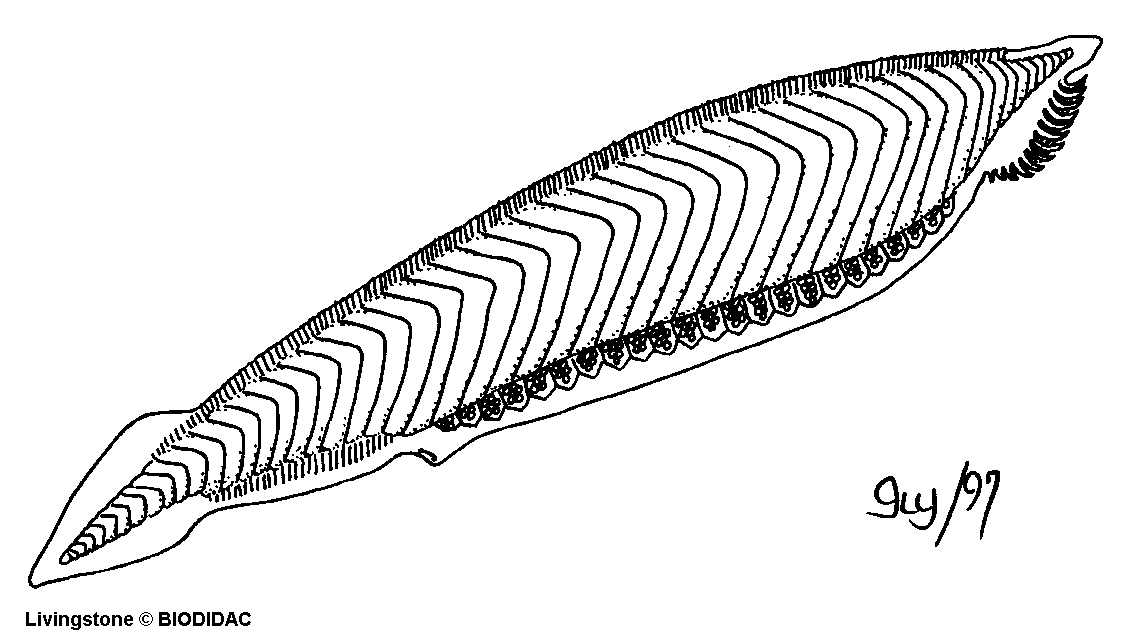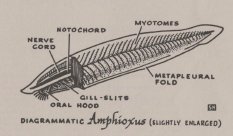The amphioxus Branchiostoma

Illustration courtesy of The BIODIDAC Project.
This song, set to the tune of "It's a Long Way to Tipperary", has verses written by Philip H. Pope (later of Whitman College) in 1921. His fiancee Louise Smith heard students in the summer course of the Biological Laboratories of the Cold Spring Harbor Laboratories on Long Island, New York singing a version of the chorus to the song "Tipperary". She suggested to Philip that he write lyrics to the song. He did. The song soon also became a favorite at the summer courses of the Marine Biological Laboratory in Woods Hole, Massachusetts. For more information about the Popes click here. On another page I have posted information on appearances of the song in MBL songbooks in 1921 and 1922, as well as a page with an image of Pope's own copy of the words.
The Amphioxus Song was also included in a small book, "Songs Of Biology", by Frank R. Brooks, published by the Beta Beta Beta biological honor society in 1948 (it may also have been in the first edition of 1939). A 1965 edition of this book was reprinted in 1978 by the MBL. Songs Of Biology credited Philip Pope with the lyrics.
The song was further popularized by the late folk singer (and marine biologist) Sam Hinton, in his well-received 1961 record "The Song Of Men: All Sorts and Kinds" (Smithsonian Folkways FA 2400).
Hinton learned the words in 1934, when he was a zoology student at Texas A&M University, from his instructor Sewell H. Hopkins. Hopkins did not sing it but declaimed it as a poem. He said that he had learned it in the 1920's in Woods Hole, Massachusetts, but he did not know the name of the author, saying only that its words were found posted on a bulletin board. MBL records show that Hopkins attended the Zoölogy course at the MBL in the summer of 1927.
The song is sometimes erroneously credited to the excellent present-day Seattle-area songwriter Mark Graham, who does not claim it.
Performance by Hinton (MP3 format)
A video of a performance by me (Quicktime movie) shot by Anna Malaspinas at the 2010 annual retreat of the Bioinformatics and Computational Biology Program of the University of California, Berkeley, at the Marconi Center, Marshall, California, another of my performances, this one at the Workshop on Molecular Evolution in 2011 at the MBL in Woods Hole, and my 2015 performance there.
|
A fish-like thing appeared among the annelids one day. It hadn't any parapods nor setae to display. It hadn't any eyes nor jaws, nor ventral nervous cord, 00 But it had a lot of gill slits and it had a notochord. Chorus: It's a long way from Amphioxus. It's a long way to us. It's a long way from Amphioxus to the meanest human cuss. Well, it's goodbye to fins and gill slits, and it's welcome lungs and hair! It's a long, long way from Amphioxus, but we all came from there. It wasn't much to look at and it scarce knew how to swim, And Nereis was very sure it hadn't come from him. The mollusks wouldn't own it and the arthropods got sore, So the poor thing had to burrow in the sand along the shore. He burrowed in the sand before a crab could nip his tail, And he said "Gill slits and myotomes are all to no avail. I've grown some metapleural folds and sport an oral hood, But all these fine new characters don't do me any good. (chorus) It sulked awhile down in the sand without a bit of pep, Then he stiffened up his notochord and said, "I'll beat 'em yet! Let 'em laugh and show their ignorance. I don't mind their jeers. * Just wait until they see me in a hundred million years. * My notochord shall turn into a chain of vertebrae And as fins my metapleural folds will agitate the sea. My tiny dorsal nervous cord will be a mighty brain And the vertebrates shall dominate the animal domain. (chorus) * note -- the two lines marked by asterisks are not the original words, which are: I've got more possibilities within my slender frame Than all these proud invertebrates that treat me with such shame. |

Well, yes and no. The origin of the chordates from the annelids is an obsolete idea (you could come closer by singing "among the tunicates" or, better yet, "among echinoderms" instead). But the Cephalochordates (the group consisting of the species of amphioxus) do in fact seem to be the closest relative (sister taxon) of the craniate chordates (the hagfish and the vertebrates). This was proposed almost 150 years ago. In between, it fell out of favor. But molecular evolution studies have restored Branchiostoma to this honorable position. However, more recent molecular evolution studies have suggested a more intriguing possibility: the tunicates (sea squirts) may be more closely related to us than is the amphioxus. The cephalochordates (the amphioxus species) may have branched off the chordate line before the tunicates separated from the craniate chordates. If so, this makes the amphioxus more rather than less interesting, as reflecting an even earlier state of chordate evolution. The matter is under debate; stay tuned.
I had asked him whether the song originated from MBL or WHOI (the better-known Woods Hole Oceanographic Institution next door to the MBL). (I later found out that WHOI could not have been involved as it didn't exist at that time).
From: SLHinton17 @ aol.com Received: (from root@localhost) by emout01.mail.aol.com (8.7.6/8.7.3/AOL-2.0.0) id WAA06281 for joe @ genetics.washington.edu; Tue, 18 Feb 1997 22:18:31 -0500 (EST) Date: Tue, 18 Feb 1997 22:18:31 -0500 (EST) Message-Id: <970218221829_-1776149618 @ emout01.mail.aol.com> To: joe @ genetics.washington.edu Subject: Re: A Long Way to Amphioxus Status: RO I wish I could be certain about this, but can't. In 1934, when I was a freshman zoology major at Texas A & M, I learned this song from Mr. Sewell H. Hopkins of the Zoology Department. He said that it dated from sometiime in the '20's, and that he had learned it at Woods Hole. He didn't specify WHERE at Woods Hole. But I think it more likely that he had been at MBL rather than WHOI; I know he went on to obtain a PhD somewhere, and he became Director of the State Fish, Game and Oyster Commission of Virginia-- and that sounds more like an MBL guy than a WHOI one! Mr. Hopkins didn't sing it for me, but declaimed it as a poem, with quite vivid histrionics. He did say that, wherever it was, it had appeared anonymously on a bulletin board. Some have tried to credit it to Prof. Walter Garstang (1868-1949) of the U.K., but I understand he disavowed it, and it does not appear in his book of collected poems entitled _Larval Forms_.(Oxford: Basil Blackwell, 1962 [3rd printing]}. In his day Amphioxus (now _Branchiostoma_) was often cited as proving the theory of recapitulation, and Garstang was the first scientist to try to repudiate that theory. One of his last communications was to the effect that Amphioxus most nearly represented a paedomorphic neotenous larva of a Cyclostome. So I guess he didn't write the song! When I sing it these days, I try to warn the audience not to take seriously the idea that there is some sort of Lamarckian tendency toward complexity and "perfection" in the processes of evolution.... Anyway, I think you should sing it as an MBI creation, and ask the audience if anyone knows for sure. I wish I could hear your lecture and singing!
In the liner notes to his record: "Sam Hinton Sings the Song of Men: All Sorts and Kinds", Folkway Records, FA2400, Hinton wrote:
For some years this was practically the theme-song of the summer students at the Woods Hole Biological Institution in Massachusetts; it was made up by persons unknown back in the days when _amphioxus_ (now technically known as _Branchiostoma_) was thought to resemble the theoretical ancestor of all the vertebrate groups. Nowadays, most systematic biologists agree that amphioxus is a sideline, and that the sea-squirts and other ascidians are more like our Great-Great-Great-to-the-Nth-power Grandparents. It's still a good song, though, and has a sort of cheerful optimism for the future that we need today .... I learned it when I was a freshman at Texas A&M College, from Dr. Sewell H. Hopkins of the Zo Department, and I shall never forget the deep feeling and fervor with which he used to declaim it.
Nicholas Hopwood has witten a charming historical article about the fascination with the amphioxus in the 1800s. It includes the words and translations of two humorous songs in German about the amphioxus and its scientific significance. Neither song is similar in tune or words to the present Amphioxus Song. This web page is referenced in Hopwood's article.
Here is a link to Hopwood's article.
This page prepared by Joe Felsenstein. I am indebted to the late Sam Hinton, Jeff "Dr. Chordate" Moran, Joel Weintraub, Heidi Dobson, Jean Monahan (MBL Archivist), Clare Bunce (CSHL Archivist), and especially to the late Arthur Rempel of Whitman College and the late Edith Pope Patten of Shoreline, Washington, who shared recollections and provided materials about Art's friends and Edith's parents Philip Pope and Louise Smith Pope.